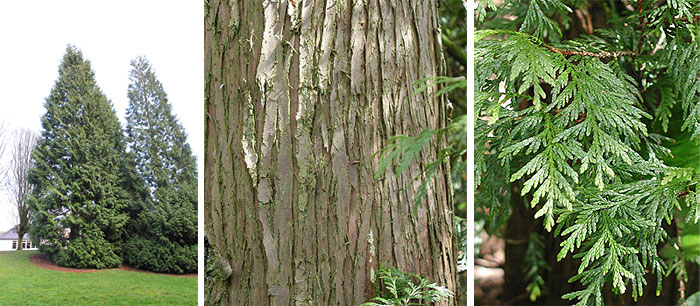The Trees at Keele
Western Red Cedar Thuja plicata

Origin: regarded as the number one resource for the native peoples of the pacific northwest of North America, it is appropriately also called the Tree of Life.
The seemingly endless uses included the famous dugout canoes, lumber for longhouses, clothing from the bark, incense, and even diapers! These beautiful trees can live to be ancient giants, growing to be over 5 meters in diameter, and reaching ages of over 1500 years. The wood is famous for being rot resistant, while the tannin rich bark resists insect invasion. The vertically fibrous bark, and unique odour of the leaves when crushed are perhaps the best way to identify this species along side other close relatives.
Preferring moist to wet soils, this tree is often found in its native habitat near streams and in the temperate rain forests. Over the years it has developed a close relationship with the pacific salmon (Oncorhycuus sp) – as the salmon come up rivers and streams to spawn, they rest in the pools created by the downed cedar logs criss-crossing the water. When the salmon die and decompose, their bodies carrying nutrients from the ocean contribute to the forest soils, enhancing the growth of the cedars. Contributed by Erik J. Wilson.
Introduced around 1850, it is very common as a specimen tree in parks and gardens and is also used in hedging. In forestry, it is sometimes planted under other crops such as Larch or some hardwoods

The bark is a dark red or purplish brown with ridges broken into strips and plates. The shape is conic with an erect leading shoot.
The foliage consists of flattened scales, shiney-green on the upperside (photo above left), matt green beneath with whitish suffusion (photo above). The merest touch of the leaves produces a pleasant pineapple or fruity smell.
The cones (above right) are small and oval.
The Lawson Cypress is very similar but differs in that it has a drooping leading shoot, matt foliage with a smell of parsley and rounded cones.
Location : There is a group of 3 trees with fastigiate Hornbeams near Keele Hall car-park - square O9, and another by lake 2 square P12.

